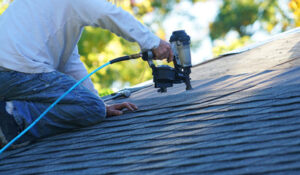Handymen perform a wide variety of tasks around the home. They can tackle your honey-do list, hang pictures and shelves and even repair squeaky steps. Handymen differ from contractors, who must be licensed to perform certain types of construction work.

A handyman’s expertise, time-saving convenience and commitment to quality make them a valuable resource for homeowners. The best handymen are versatile experts, able to tackle a range of different tasks efficiently and safely. Contact Handyman Mesa AZ for professional help.
A handyman’s tools help them complete a wide range of projects and repairs. Choosing the right tools saves time, ensures safety, and promotes efficiency. Here are some basic tools to consider for any handyman’s toolkit:
A set of pliers is essential for many DIY tasks, including gripping, bending, and cutting wires. A versatile pair of slip-joint pliers is a good starter choice, but you should also add needle-nose and locking pliers to your collection.
Drills
A quality drill is a handyman’s most versatile tool, opening up countless possibilities for DIY projects. A cordless drill with different bits is ideal for quick, easy drilling and screw driving. It’s worth spending a little more for a durable, high-quality model that will last you years.
Hammers
Handymen rely on hammers for various assembly and demolition tasks, so it’s important to keep an efficient, reliable hammer in your kit. A claw or ball-peen hammer is a good choice for most situations, but you should also keep a sledgehammer in your toolbox for more extreme jobs.
Tape Measure
A reliable tape measure is indispensable for handymen, helping them make precise measurements on the fly. A simple 2-meter folding ruler is a great option for most jobs, but you should also add a longer model or a tape with a built-in level for more precision.
Saws
Stocking a variety of handsaws in your toolbox is an essential part of being a versatile handyman. A basic handsaw can handle everything from cutting smaller wood pieces to trimming drywall, but you should also include other types of saws in your toolkit. A circular saw is great for cutting larger boards, while a handheld drywall saw can save you valuable time on certain jobs.
Other important handyman tools include a combination square for checking depths, a compass for marking curved measurements, and a utility knife with spare blades. It’s also a good idea to have a roll of masking or painters’ tape and a few twist ties on hand for temporary fixes. Keeping your toolbox organized is also essential for minimizing clutter and making it easier to find what you need.
Power Tools
Handymen must have a variety of power tools to tackle a wide range of projects. They can include electric drills, cordless screwdrivers, saws, and other types of powered hand tools. These tools can make some tasks much faster and easier to complete. A handyman should also have a tool bag or tool box to keep their tools organized. This helps them find the right tool quickly when a job is in progress and avoids time wasted searching.
A basic tool kit should start with reliable hand tools like a hammer and screwdriver set. Then a handyman can slowly add power tools as needed for larger jobs. For example, a good quality circular saw is essential for cutting wood and other materials to size. It should be versatile enough to cut with different blades for different uses. A quality sander is also a must to achieve a smooth finish on woodworking projects like shelves, bookcases, or tables. A reciprocating saw is a versatile power tool for demolition and other tough tasks that require quick, accurate cuts.
Keeping a handyman’s power tools in good condition is important for efficiency and safety. They should be regularly inspected for signs of wear and tear and repaired or replaced as needed. Proper storage is also essential to prevent dust or moisture from damaging the tools. Some tools may require lubrication to keep them running smoothly. Handymen should refer to the manufacturer’s instructions for the recommended type and frequency of lubrication.
Other power tools a handyman may need to have include a portable work light, an extension cord, and a battery charging station or generator. A portable work light is useful for lighting up dark spaces to see the details of a project. A battery charging station or generator is a must for keeping batteries charged and ready to use when a job starts. This saves valuable time that could be spent searching for an outlet or waiting for a tool to charge up. A stud finder is another handy tool that allows the handyman to locate the location of electrical outlets, plumbing pipes, and other structural elements before drilling into them.
Safety Equipment
Handymen often work with sharp tools, power equipment, and hazardous materials. It’s important for them to be fully equipped with the right safety equipment, so they can avoid injury while performing their job. This includes wearing gloves, eye protection, and work clothing that’s appropriate for the job at hand. It’s also crucial to have a clean and organized workspace that’s free of trip hazards and debris. Handymen should also maintain a proper inventory of their tools and materials, and ensure that they’re properly stored when not in use.
Physical injuries are a common risk associated with the handyman profession, but can be mitigated through stringent safety protocols, comprehensive training on tool use and safety procedures, and ensuring that all employees have access to the necessary equipment. Keeping a first aid kit on hand, maintaining a clean work environment, and inspecting all equipment for potential hazards are other essentials to protect against accidental injuries. Handymen should also consider purchasing general liability insurance, which can help cover financial loss if they’re held responsible for damage or injury caused by their work.
A reliable and skilled handyman can offer a valuable service to homeowners by providing a range of repair and maintenance services. This can include fixing appliances, repairing plumbing and electrical issues, painting and repainting homes, and replacing damaged fixtures and furnishings. While some of these jobs may be easy for a homeowner to undertake, it’s usually best left to professionals with the knowledge and experience required to ensure the job is completed safely and correctly.
Taking the proper precautions before beginning a DIY home improvement project is essential to protecting yourself, your family, and your property. Handymen are typically hired to take on more complex projects that require more advanced tools and techniques than do-it-yourselfers can easily handle. Taking the time to prepare and properly equip yourself with the right tools, materials, and safety equipment can minimize your risk of injury while saving you the stress and hassle of tackling a larger project on your own.
Handymen encounter a wide array of risks in their professional lives, from physical injuries and health hazards to financial vulnerabilities and reputational challenges. However, by embracing proactive risk management strategies and securing comprehensive insurance coverage, handymen can safeguard their businesses against unexpected obstacles and secure long-term success.
Communication Skills
Handymen need to be able to communicate clearly with their clients. This is vital for ensuring that everyone understands what needs to be done and the expected outcome of the work. It also helps to prevent miscommunication and misunderstandings that can delay or derail the progress of a project.
Problem-Solving Skills
One of the core skills that distinguish a competent handyman is their ability to analyze a situation and find effective solutions. This can involve troubleshooting plumbing problems, identifying the cause of a squeaky door hinge, or determining the best way to hang a picture frame. In addition, a good handyman must be able to assess a task’s complexity and determine whether or not it is within their scope of expertise.
Carpentry Skills
A handyman should have basic carpentry skills, such as the ability to build and repair structures using wood. They should also know how to install shelving and cabinets, hang doors and windows, and make minor alterations to existing furniture. Handymen often use their carpentry skills when performing general maintenance tasks like painting, plastering, and tiling.
Plumbing Skills
A basic knowledge of plumbing is essential for handymen, as they may be called upon to unclog drains, fix leaky faucets, or replace showerheads. They should also be aware of common safety precautions when working with water lines.
Electrical Skills
Electrical work is another common task that handymen perform, and it is important for them to have the knowledge necessary to safely handle these tasks. This includes understanding how to properly wire outlets and light fixtures, as well as recognizing the difference between live and dead wires. Handymen who have these skills can help prevent fires and other electrical hazards by ensuring that their work is up to code.
In addition to technical skill sets, physical fitness, and licensing, hiring a qualified handyman also requires excellent communication and problem-solving skills. By taking the time to interview potential handymen and checking references, you can be sure that the person you hire will be able to effectively complete your home repairs.

